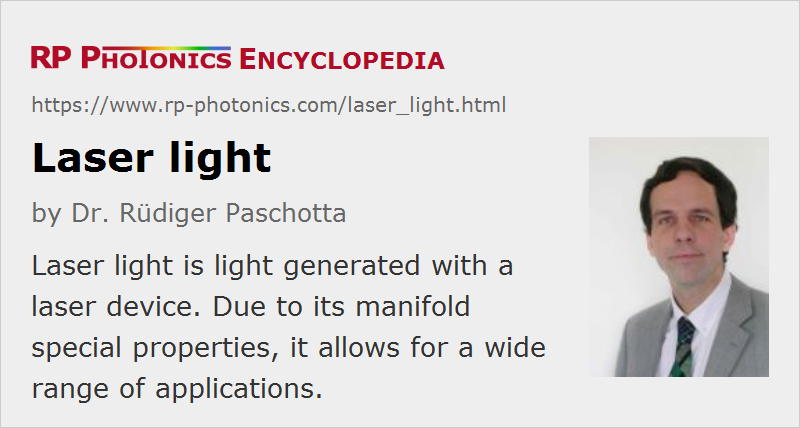Laser Light
Definition: light generated with a laser device
More general terms: light
German: Laserlicht
Categories: general optics, lasers
How to cite the article; suggest additional literature
Author: Dr. Rüdiger Paschotta
Laser light (laser radiation) is simply light generated with a laser device. Such light has some very special properties, which very much distinguish it from light with other origins:
- Laser light is usually delivered in the form of a laser beam, i.e. it propagates dominantly in a well-defined direction with moderate beam divergence. Such a laser beam has a high (sometimes extremely high) degree of spatial coherence. This means that the electric fields at different locations across a beam profile oscillate with a rigid phase relationship. Exactly this coherence is the reason why a laser beam can propagate over long distances without spreading very much in the transverse directions, and why it can be focused to very small spots (high focusability of laser beams).
- In many but not all cases, laser light also has a high degree of temporal coherence, which is equivalent to a long coherence length. This means that a rigid phase relationship is also maintained over relatively long time intervals, corresponding to large propagation distances (often many kilometers) or to huge numbers of oscillation cycles.
- The large temporal coherence, quantified with a large coherence time or coherence length, is associated with a narrow spectral bandwidth (or linewidth). (We exclude here the sophisticated case of trains of ultrashort pulses, which can have a large optical bandwidth but nevertheless a high degree of coherence; see the article on coherence for details.) For a visible laser beam, this means that it has a certain pure color, e.g. red, green or blue, but not white or magenta. Some lasers allow a degree of wavelength tuning (e.g. dye lasers). The large coherence length introduces a tendency for the phenomenon of laser speckle, i.e. a characteristic granular pattern which can be observed e.g. when the laser beam hits a metallic surface.
- In most cases, laser light is linearly polarized. This means that the electric field oscillates in a particular spatial direction (→ polarization of light).
Depending on the case, laser light can have other remarkable properties:
- Laser light may be visible, but most lasers actually emit in other spectral regions, in particular in the near-infrared region, which human eyes cannot perceive.
- Laser light is not always continuous, but may be delivered in the form of short or ultrashort pulses. As a consequence, the peak power can be extremely high – for some amplified laser systems well above 1 TW (1012 W) – if the pulse duration is far below the temporal distance of the pulses, so that a large pulse energy is possible.
- The noise properties of lasers can also be very interesting (→ laser noise). For example, the oscillation frequency of a laser can be stabilized to stay within an extremely narrow range.
For comparison, light from an incandescent lamp is partly visible and mostly infrared, has a very high spectral bandwidth, cannot be strongly focused (because of low spatial coherence), and cannot be generated in the form of short pulses.
Laser light can cause significant hazards, particularly for the eye, but also for the skin, apart from fire hazards and others. Lasers pulses are often particularly dangerous, because they can have enormously high optical intensities, and invisible laser beams add specific risks. See the article on laser safety for details.
Questions and Comments from Users
Here you can submit questions and comments. As far as they get accepted by the author, they will appear above this paragraph together with the author’s answer. The author will decide on acceptance based on certain criteria. Essentially, the issue must be of sufficiently broad interest.
Please do not enter personal data here; we would otherwise delete it soon. (See also our privacy declaration.) If you wish to receive personal feedback or consultancy from the author, please contact him e.g. via e-mail.
By submitting the information, you give your consent to the potential publication of your inputs on our website according to our rules. (If you later retract your consent, we will delete those inputs.) As your inputs are first reviewed by the author, they may be published with some delay.
See also: lasers, laser beams, coherence, laser speckle, pulses, laser safety, laser noise, polarization of light
and other articles in the categories general optics, lasers
 |



If you like this page, please share the link with your friends and colleagues, e.g. via social media:
These sharing buttons are implemented in a privacy-friendly way!